The 4th Foreign Infantry Regiment (4e REI) was an infantry unit of the French Foreign Legion. Established in Morocco in November 1920, the regiment participated in the Pacification of Morocco and in the Rif War. Dissolved in 1940, its flag saw Senegal and Tunisia during World War II, then entrusted to the 4th Demi-Brigade.
Recreated in 1946, the regiment took part in the Madagascar campaign in 1947-51, in the Indochina War, in operations in Morocco in 1954-55, as well as in the Algerian War in 1957-62. The 4e REI was dissolved in the Sahara in 1964. Its number, history and traditions were adopted by the training regiment of the Legion in Castelnaudary in June 1980.
La version française de cet article: 4e Régiment Etranger d’Infanterie

Introduction
In North Africa in 1907, faced with attacks against its nationals and threats to the Algerian-Moroccan borders, France decided to intervene in Morocco. The legionnaires led the assault troops. In 1912, the treaty for the organization of the French protectorate in Morocco was signed. The pacification of the country began.
During the First World War of 1914-1918, several battalions and mounted companies of the Foreign Legion crisscrossed Morocco and defended the already pacified territories. A very difficult task since the Moroccan rebels armed from abroad had been encouraged by the departure of a large number of French troops for the Western Front in Europe.
Once the war in Europe was over, the battalions and mounted companies of the Legion, exhausted by both the terrible fighting and lack of manpower, became autonomous and continued to pacify Morocco. But in 1920, with a new rush of recruits from Europe shattered by the recently finished conflict, and in consideration of the new geopolitical tasks for France, the Legion would be completely reorganized.
It was therefore on 30 September 1920 that the Minister of War decided to reunite the various independent battalions stationed in Morocco and prescribed the formation of a new Foreign Legion regiment (in fact, two old Legion regiments would be reconstituted and, furthermore, three new ones organized in Algeria, Morocco and Tunisia between the end of 1920 and the beginning of 1921).
Creation of the 4th Foreign Regiment
The 4th Foreign Regiment (4e RE) was constituted on 15 November 1920. Initially, it was formed with four battle-toughened battalions, having served in Morocco for several years already. One of the mounted companies was also attached to the regiment. Quickly nicknamed the “Regiment of Morocco”, the new unit was made up of 78 officers, 197 non-commissioned officers and 3,384 legionnaires (i.e. 3,659 men). The HQ was located in Meknes, a city in the north of the country, between the Rif and Middle Atlas mountains. Lieutenant Colonel Lucien Maurel took command of the regiment. He served as a captain with the Legion in 1904-09.
Composition of the 4e RE in November 1920:
- HQ + HQ Company (CHR) in Meknes
- 1st Battalion (ex-1st Battalion of 1er RE) in Benni Mellal: Major Lambert
- 2nd Battalion (ex-2nd Battalion of 1er RE) in Marrakech: Major Astraud
- 3rd Battalion (ex-6th Battalion of 1er RE) in Bou Denib: Major de Corta
- 4th Battalion (ex-6th Battalion of 2e RE) in Meknes and Ain Leuh: ??N/A??
- 1st Mounted Company (ex-1st Mounted Company of 1er RE) in Bou Denib: ??N/A??
In early 1921, the regiment was replaced in Meknes by the freshly reconstituted 2nd Foreign Regiment. The 4th Battalion of 4e RE, also stationed in this town, rejoined its former regiment. Meanwhile, the HQ of the 4e RE would move towards Marrakech.



4th Foreign Regiment in the Levant in 1921-1926
In 1920, a mandate founded by the League of Nations allowed France to administer in the Levant (a vast region in the Middle East) Syria and Lebanon, the countries of the former Ottoman Empire occupied after the First World War.
To participate in the pacification of these territories still unknown to the legionnaires, a new 4th Battalion, 4e RE was organized in February 1921 in Saïda, the former garrison of the 2nd Foreign Regiment in Algeria. A month later, this battalion of Major Salvat landed in the Levant. In September, they were reinforced there by the 5th Battalion, also organized in Saïda and placed under the command of Major Goepfert.
These two 4e RE battalions, each comprising three infantry companies and a mounted company equipped with mules, would never discover Morocco. The 4th returned to Algeria in 1924 to be disbanded there, after four years of maintaining order, road works and building bridges or military posts in Syria. The 5th Battalion would remain in the Levant to do credit to the Legion during the Druze Revolt (1925-1927), especially during the Battle of Messifre in September 1925. After these hard fights, the battalion left the 4e RE to become a battalion of the 1er REI. To find out more: The Foreign Legion in Syria and Lebanon: 1921 – 1939
Pacification of Morocco in 1921-1934
In Morocco in 1921, only three battalions of the 4th Foreign Regiment remained there, grouped in Marrakech. They would immediately engage in the pacification of the country. Until 1924, the battalions and the mounted company were operating in the massifs in the west of the Middle Atlas and assisting in the reduction of the “Taza spot” (Tache de Taza), north of that town. One by one, the rebel tribes descended into the valleys and submitted.
To conquer new lands, the battalions made part of mobile groups, large-strength units of combined arms. The legionnaires spent long weeks in columns, before returning to their garrisons for a brief rest. At the same time, known as soldiers and builders, they contributed to the construction of posts or blockhouses, roads, bridges. During the winter, the men remained in their outposts.
In June 1922, because of a decree prescribing the official creation of the 1er REC, the infantry regiments of the Foreign Legion changed their title. So, the 4e RE became 4e REI. On November 11 of the same year, the regiment received its flag.
In 1921, in the north of Morocco, the Berber tribes of the Rif mountains rose in revolt against the Spanish Protectorate in Morocco (set up in 1912, by the Franco-Spanish convention). After a period of neutrality, France joined Spain in late 1924 to fight against the Riffians and their leader, Abd el-Krim. Several battalions of the French Foreign Legion, including those of the 4e REI (1st + 2nd), would fight alongside the Spanish Legion. The enemy was well organized, well armed and very combative. But finally, at the end of May 1926, the Franco-Spanish alliance forced the Riffians into capitulation. The 2nd Battalion, 4e REI would be mentioned in dispatches, in the order of the Army, the highest degree.





Three months later, an element of military engineering appeared within the 4e REI – Company of Sappers-Pioneers (CSP), activated on August 24, 1926. Administratively assigned to the CHR, the pioneers were mostly occupied with road construction, such as the road from Marrakech to Ouarzazate, going through the Tizi n’Tichka pass. An extraordinary work 138 miles (220 km) long.
From 1926 to 1933, the legionnaires of the 4e Etranger were operating in the south of the country, participating in the penetration and occupation of the rest of the High Atlas and Anti-Atlas mountain ranges. Based in Marrakech, Ouarzazate and Agadir, the three battalions crossed the unknown zone towards Mauritania; one of them supported the reduction of the “Great Spot” (Grande tache), a badly accessible area in the Atlas occupied by rebels. The Mounted Company, then based in Kerrando, protected convoys supplying the outposts in the sector. Besides, the units of the 4e REI, as always, were building new roads, posts or setting up airfields to better eliminate the rebels and pacify the country as soon as possible.
The year 1932 marked the resumption of the French offensive. Therefore, apart from infantry, cavalry and engineers, a new army component completed the regiment: Marching Battery, an artillery unit formed on May 16, 1932. The Battery was equipped with four French 75 mm field guns M1897, transported on trucks of a transport company (CAT). Late in 1932, the battery would be stationed in Ouarzazate.
In February 1933, the legionnaires of all four regiments took part in the hard fights at Djebel Sagho (see the 1933 Battle of Bou Gafer), against the confederation of the Aït Atta tribes. It was one of the last major campaigns conducted by French troops against Moroccan dissidents. The 1st and 3rd Battalions and the Marching Battery of the 4e REI were involved. In June-September, the last operation for the battalions of the already regrouped 4th Foreign Regiment took place: the conquest of Djebel Baddou, a mountain in the High Atlas.
In the meantime, on April 15, 1933, the Mounted Company of the 4e REI was partly motorized and became the Compagnie Montée Automobile (CMA/4), commanded by the famous Captain Gaultier. The unit would participate in early 1934 in the Anti-Atlas campaign in the extreme south of Morocco. This campaign saw the first fully motorized operation of the French Army, led by Colonel Trinquet. Four motorized units of the Legion took part in, supported by the CSP and the Battery of the 4e REI. In March 1934, the remarkable operation would successfully conclude the twenty-seven years of France’s pacification of Morocco, in which the Foreign Legion had participated since the very beginning…
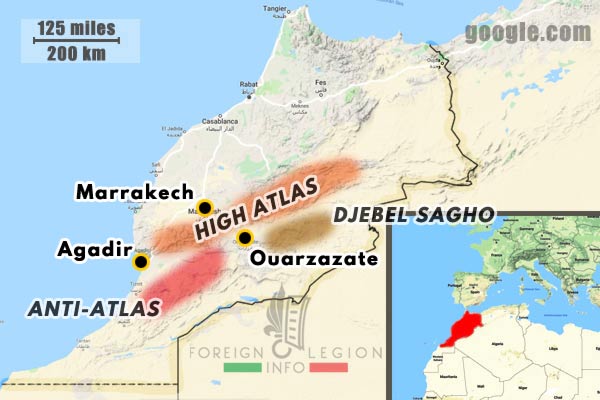





4th Foreign Regiment in Morocco in 1934-1940
In 1934, the period of more than thirteen years of fighting was over for the 4e REI. After the pacification was successfully over, Morocco would have been transformed into a huge construction site, with legionnaires participating in various work tasks. Each year, the regiment completed tens of kilometers of roads. The 4e REI men also proved their skills during the transformation of the port of Agadir or during the irrigation of the Souss valley.
In the south, the CMA split into two parts to build the posts of Foum El Hassan (their garrison) and that one of Tindouf, located in western Algeria, near the border with Mauritania. A rotated detachment of the company would be still present there (until 1940) to maintain order in the area and to set out far away for Mauritania, as far as Fort Trinquet. It was a very exceptional mission among the Foreign Legion units based in Africa back then.
Composition of the 4e RE in 1935:
- HQ + HQ Company (CHR): Marrakech
- 1st Battalion: Marrakech
- 2nd Battalion: Ouarzazate
- 3rd Battalion: Agadir
- Automobile Mounted Company (CMA): Foum El Hassan
- Company Sappers-Pioneers (CSP): Marrakech
- Marching Battery: Ouarzazate
The period from 1935 to late 1939, marked by total peace throughout Morocco, was devoted to construction tasks, instruction, maneuvers, patrol tours, and the modernization of the regiment’s units. Five years without any struggle for legionnaires. A very rare epoch…
However, in September 1939, the sad events in Europe interrupted the peaceful time. The order for war mobilization arrived. The CSP was dissolved. Detachments were formed within the 4e REI battalions to deploy to Europe. Nearly 500 legionnaires from the 4th Foreign Infantry Regiment would constitute in Metropolitan France the embryo of two new regiments (11e REI + 12e REI); three companies would be assigned to the 13th Demi-brigade for the Norwegian campaign. Also, two other detachments left North Africa to reinforce the 5e REI in Indochina and the 6e REI in Syria and Lebanon.
In Morocco, the sufficiently reduced 4e REI was continuing to carry out its missions. Its artillerymen, who had been redesignated Motorized Battery since late 1939, moved to the town of Port-Lyautey to defend the Atlantic coast. They were reinforced on the coast by the 2e REI’s Battery, transferred to the 4e REI. A third motorized battery was formed within the regiment in 1940, in Mogador, tasked with the same mission. But the lack of personnel and the Armistice signed with Germany in June 1940 would lead to the reorganization of the French Army, including the Foreign Legion and the regiment itself. As of November 15, 1940, the 4e Etranger of Lt Colonel Gentis ceased to exist, twenty years after its creation.
The next day, the regiment still based in Marrakech became the new 2e REI, reinforced by elements from the latter dissolved on the same date. The legionnaires from the 1st Battalion of the new 2e Etranger, that battalion designated to keep the traditions of the Regiment of Morocco, would wear the number “4” on their collar patch.


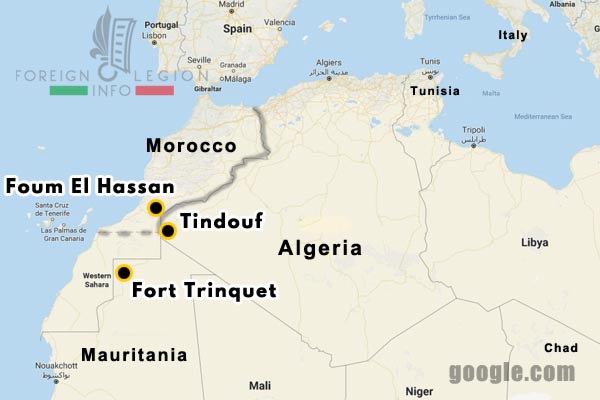






4e DBLE in Senegal in 1941-1943
To move over in North Africa so that the survivors of the 6e REI returning from the Levant could serve there, a demi-brigade was activated on August 16, 1941 to reinforce French troops in Senegal. This country of French West Africa (AOF) had already seen a failed British landing attempt and was expecting another one. The new demi-brigade was formed with 1er REI units: its regimental combat support company, two battalions and a company of the 3rd Battalion. On August 25, the formation landed in AOF, soon completed by legionnaires originally sailing to Indochina; the latter being blocked by the British in the south of Senegal had to make u-turn.
Under the title of 4th Foreign Legion Demi-Brigade (4e DBLE), the new unit received the old flag of the 4e REI. Lieutenant Colonel Auguste Gentis took command; he was the last commanding officer of the 4th Foreign Regiment. Stationed in Saint-Louis (then the capital of both AOF and Senegal; HQ + 2nd Bn) and in Dakar-Bango (1st Bn), the demi-brigade was mostly occupied with the development of their installations, with training and maneuvers.
To avoid the lethargy and monotony of the service in Senegal, and to strengthen the cohesion of the troop, walking bush tours of two to three weeks would be organized for platoons in this desert territory with a climate beyond endurance.
Meanwhile, a Company of Sappers Pioneers (organized in Morocco within the 2e REI) joined in September the 4e DBLE. A slightly mystical unit, barely known, with its detachments based in Kéllé, Rosso and even in Mauritania, in Nouakchott, the CSP would be tasked in particular with improving the imperial road connecting Algeria and Senegal.
At the beginning of November 1942, a successful Allied invasion took place in French North Africa. It turned the political situation and the course of war. French troops in Africa would resume the fight with Germany. In March 1943, the 4th Foreign Legion Demi-Brigade left Senegal for Morocco.
1er REIM in Tunisia in April-May 1943
Having joined the Allies, the French troops in North Africa were ready to participate in the campaign of Tunisia, against the forces of the Axis (Germans and Italians). After four weeks spent in Morocco, the 4e DBLE was sent by train to Tunisia to incorporate the 1st Battalion, 1er REI of Major Pénette and form a new unit. On April 16, 1943, the 1st Foreign Infantry Regiment Combat Team (1er REI de Marche, 1er REIM) was activated under the flag of the 4e REI, with Colonel Gentis still keeping the command.
The regiment would participate in the Tunisian campaign alongside their comrades from the 3e REIM. The legionnaires were involved in the heavy fights at Djebel Mansour, Djebel Rhian, Djebel Alliliga, in Sidi Abd El Kerim and, above all, in the plain of Pont de Fahs (trans. Bridge-of-Fahs), as well as at Djebel Oust and Djebel Zaghouan, where the Italians and Germans would surrender en masse. By 13 May, all Axis forces in Tunisia had surrendered, opening the way for the Allied invasion of Sicily in July.
As of May 30, the regiment was disbanded. During its brief six-week existence filled with hard fighting in Tunisia, the 1er REIM gained a mention in dispatches, in the order of the Army, and a new battle honor emblazoned on the 4e REI’s flag: Djebel Zaghouan 1943.





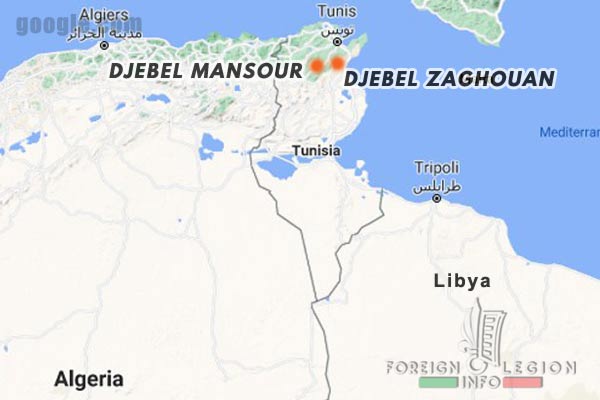

4e DBLE and 4e REI in Morocco in 1946-1954
To guarantee the presence of France and of the Foreign Legion in particular in Morocco after the Second World War, the “Regiment of Morocco” was reconstituted in Fes on May 16, 1946, initially with one battalion (1st). Nevertheless, with the situation in Indochina getting worse, there would not be enough troops to form an entire three-battalion regiment and thus, on 16 September 1946, the supposed new 4e REI became eventually 4th Foreign Legion Demi-Brigade of Morocco (4e DBLEM).
Composed of two battalions and a mule-mounted company (assigned to the demi-brigade the following month, in October; the last of its kind within the Foreign Legion and even the French Army), the 4e DBLEM kept occupied its men primarily with road construction works, improvements of their camps, maneuvers or patrol tours in the Atlas. Later, an instruction group placed in Fes would train young recruits to ease a bit the Legion’s motherhouse in Algeria of that mission.
In June 1947, the second battalion of Meknes (based in Quartier Bournazel which would later be called Quartier Bissey) left Morocco to become the first unit of the Foreign Legion in Madagascar in 1947-1951, to suppress an ongoing revolt and restore order on that French-controlled island in the Indian Ocean.
A new 2nd Battalion is therefore organized in November 1947 in Morocco, in El Hajeb, followed by a third one in October 1948, which would be stationed in Meknes. With these three battalions, the demi-brigade would be transformed and as of October 16, 1948, redesignated as the 4th Foreign Infantry Regiment.
At the same time, the ongoing war in Indochina is constantly demanding new reinforcements. Almost every month, a number of legionnaires of the “4” leave Africa for the Far East.
In September 1948, each of the two battalions (still of the 4th Demi-Brigade at that time) selected a company to help constitute in Algeria a certain 2nd Foreign Parachute Battalion (2e BEP). In June 1949, the entire 2nd Battalion of the 4e REI was ready to deploy to Indochina. Renamed the 5th Battalion and stationed in Tonkin (then title for Northern Vietnam), its legionnaires guarded the border with China and the roads connecting the territory with the Tonkinese Delta. In November 1949, the battalion would become the 2nd Battalion of the new 5e REI.
Meanwhile in Morocco, the regiment went on to serve as the reservoir of men, a depot, for those who had returned from the prescribed two-year stay in Indochina as well as for those who were designated to deploy there. A number of non-commissioned officers and legionnaires having returned from the Far East were spending their three-month end-of-campaign furlough (an extended leave) in the holiday resort of the 4e REI in Rabat. Due to the permanent lack of cadre, they could often be assigned to supervise the regiment’s training companies. The training of the young recruits by the veterans of Indochina was supplemented with military maneuvers and patrol tours.
At Ksar Es Souk at the end of 1949, the mounted company, the last of its kind, was dissolved. On January 1, 1950, it became the Motorized Company, Compagnie Portée.
The year 1950 was marked by a vast decrease of the regimental strength due to the number of legionnaires that were ordered to leave Africa for Indochina. That fact caused a new dissolution of the 4e REI, which occurred on May 31, 1951. Only two battalions remained, one in Morocco and the other still stationed in Madagascar. That one in Morocco, 1st Battalion, based at the time at Quartier Bissey in Meknes, would keep the 4e REI’s flag and traditions as a formant corps unit (that is to say a unit administratively considered as a regiment). The I/4e REI was commanded by Lieutenant Colonel Jules Gaucher.
By the end of January 1952, the 4th Battalion (ex-2nd) returned from Madagascar. Based at the Caserne Fontanel in Fes, the unit started instruction of young recruits, construction works of all kinds and maintaining order in Morroco. Not long afterward, in March 1952, after that eighteen years of peace the protectorate saw first rebel activities. The same month, the Motorized Company (also semi-autonomous at the time) left Ksar Es Souk and moved to Khenifra, to calm successfully the agitation in this rather turbulent region.
However, with the end of the war in Indochina, the situation in Morocco got significantly worse in August 1954. In the Medina of Fes (the oldest walled part of the city), the two 4e REI independent battalions took part in Operation Képi blanc (White Kepi) to restore order there. Also this year – just to have a realistic idea about the then statistics – the 4th Battalion dispatched 5 officers, 70 non-commissioned officers and 830 legionnaires in total to Indochina, while the unit itself comprised around 650 men, officers and NCOs included.













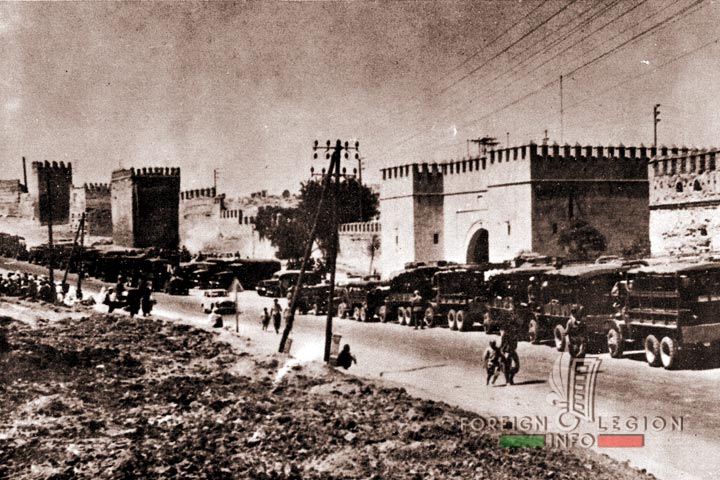
4e REI in Morocco in 1955-1957
As of March 1, 1955, the 4e REI was reconstituted, with the two battalions being autonomous up to date; the 4th Battalion regained its old number “2” from 1947. At the same time, a 2nd Motorized Company was organized in Ksar Es Souk, at the old headquarters of its sister company. The instruction of young recruits was terminated. Under the command of Colonel Gustave Borreill, a former officer of the 4e DBLE in Senegal, the 4e REI again became a combat regiment.
Its units were quickly dispatched to Casablanca, Meknes, Khenifra and particularly to Oued Zem, where a savage massacre of European inhabitants took place in August 1955. The 4e REI would restore order in all of these rebellious sectors. However, military operations would go on until late December, especially in the north, in the Rif mountains.
Nevertheless, the political situation changed considerably. The abandonment of Morocco by France would be executed to surprise of many. At the beginning of March 1956, Morocco obtained its independence. In late June, the units of the 4e REI were sent to the Algerian-Moroccan border in eastern Morocco, as far as Bouarfa and Figuig, posts lost in a desert area. There, the men would spend a very hot summer, alongside their comrades from the 2e REC. Many legionnaires saw this mission as a punishment in consequence of the Moroccan independence.
By late October, the units returned to their garrisons. On November 16, 1956, the 4e Etranger was once again reorganized to become a modern motorized infantry regiment. The two battalions were dissolved, replaced by two groupements of motorized companies (known as GCP, later EMT). By incorporating the GPLEM (also disbanded to this date), the new 4e REI was made up of six motorized companies equipped with Dodges 4×4 and 6×6, AM-M8 Greyhound armored cars and Jeeps. With the 2e REI, these were the first two motorized infantry regiments of the Foreign Legion.
While the two companies of the ex-GPLEM would move to Mauritania, the Regiment of Morocco left in March 1957 its country of origin for Algeria, where the new war had already erupted. On 18 March 1957, the 3e Compagnie Portée of Captain Gay was the last unit of the Legion to cross the Algerian-Moroccan border, leaving behind it 50 years of fighting, sacrifices and enormous work… A page in history had been turned.





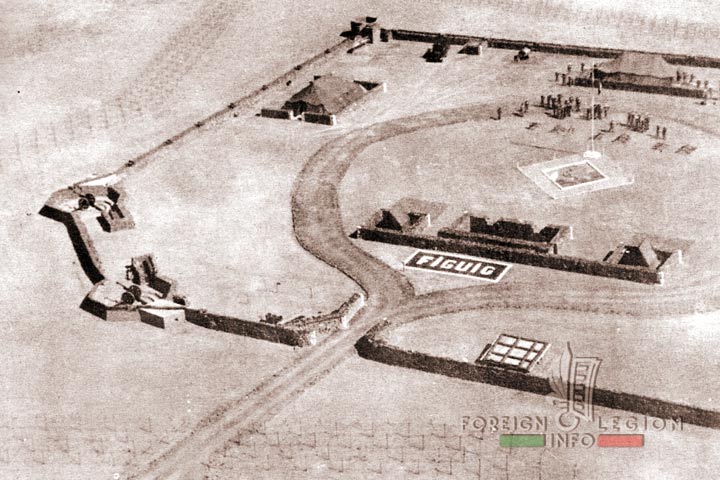
4e REI in Algeria in 1957-1964
The reorganized 4e REI moved towards Constantinois, a cultural and historical region of the Maghreb, located in northeastern Algeria. The HQ was stationed in Tebessa, with two companies based around Biskra and other two based at Bir El Ater and Negrine. Led by Colonel Maurice Lemeunier, the four companies of the regiment began to participate in the operations of the sector, against fellagas (local rebels’ nickname). The clashes, various reconnaissance, protection or liaison missions, and the construction of posts and camps followed one another. In the meantime, Harkis (auxiliary Muslims serving in a harka, a usually mounted group of a platoon size) were attached to the regiment.
The two companies coming of the ex-GPLEM, 4th + 5th, they were placed at Fort Trinquet in northern Mauritania, a French territory which the new Kingdom of Morocco claimed as its integral part. The two companies were forming the 2nd Motorized Company Group (GCP 2). Because of the large distance from the regimental HQ, the difference in the theatres of operations and in the particular missions, the GCP 2 would eventually become an independent Foreign Legion unit, on the 1st of August 1957. By the way, the 4th Motorized Company had already known Mauritania. The unit was patrolling the north of the country as far back as the 1930s, when still called as the 4e REI’s Compagnie Montée Automobile…
After having participated in military operations in Mauritania and on the Moroccan borders alongside the Spanish legionnaires (such as did the 4e REI units in northern Morocco in 1925-26), the independent GCP 2 of Major Mattei joined the rest of the regiment in Algeria in April 1958, as the last Foreign Legion unit to take part in the Algerian War.
In the meantime, on January 4, 1958, a new regimental flag was handed over to the 4e REI to replace the old one having witnessed 35 years of glory.
In 1958, a “border war” began on the Morice Line, a fenced, barbed-wired, electrified, mined and constantly monitored defensive line, which ran along the border between Algeria and Tunisia, a neighboring country where the rebels had built their main camps and depots. The order was to neutralize all rebel groups crossing the border line with Tunisia. Several Legion units would be involved in this mission, including the 4e REI.
With the regimental HQ based since late March 1958 at Bir El Ater, south of Tebessa, the companies were carrying out day and night patrols along the electrified line and chasing the fellagas, alongside squadrons of the 1er REC.
However, in August 1959, the 4e REI had to leave Bir El Ater and move even further north of Algeria. The regiment settled in a territory between Bône, La Calle, Lamy and Guelma to stay there until February 1962, keeping always the same mission: to guard the border.
In February 1962, the 4e REI returned to the south, to the Negrine sector, but not for long. As of March 19, 1962, the Algerian War was over and, on July 3, France would recognize the independence of Algeria. During the fighting in this country, 3 officers, 8 non-commissioned officers and 60 legionnaires of the 4e REI died for France.
After independence, the regiment moved south to be spread across the Saharan desert, between Touggourt, Ouargla and Hassi Messaoud. The legionnaires were marking out the tracks there and protecting the oil plants. In March 1963, the 2e CSPL and 3e CSPL merged with the regiment.
In mid-1963, the 4e REI gained the great south of the Sahara (In Amenas, Fort Flatters, In Salah, Amguid) and thereafter, in October-December, western Algeria, stronghold of the 2e REI. The companies were stationed around Colomb Béchar, with the HQ based in Reggan. There, a few months later, a vast reorganization of the French Army in North Africa hit the already significantly reduced regiment. A final ceremony occurred in Reggan on April 25. Thereafter, on April 30, 1964, Camerone Day, the 4th Foreign Infantry Regiment was disbanded. This is the definitive disappearance of the 4e REI from the African soil.
Such as in 1940, the legionnaires of the disbanded 4th Foreign Regiment merged with the 2e REI. Meanwhile, the regimental military band joined the 2e REP. The flag was deposited in the Legion’s Hall of Honor in Aubagne. It would not be withdrawn until September 1977, when handed over to the newly created Foreign Legion Instruction Regiment (RILE) in Castelnaudary. In June 1980, the latter would become the 4th Foreign Regiment (4e RE) while guarding the number, insignia, history and traditions of the former Régiment du Maroc. The legend continues…
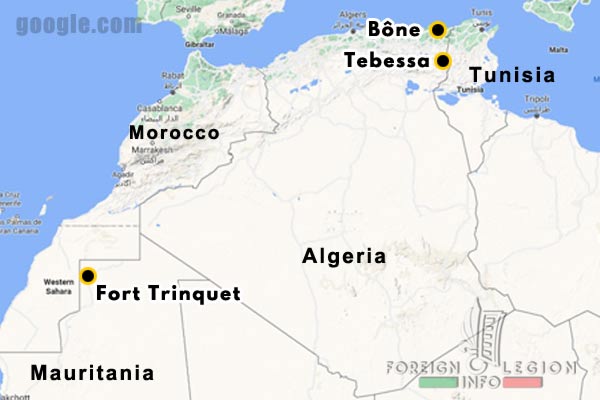


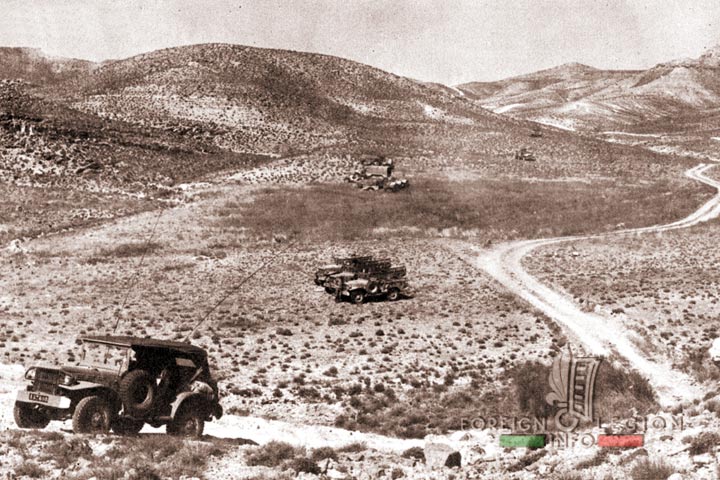











4th Foreign Infantry Regiment in 1920-1964: Addditional Image & Document Gallery







































4e REI: Commanding Officers
| PERIOD | COMMANDER | |
|---|---|---|
| 4e RE | 1920-1922 | Lcl MAUREL Lucien |
| 4e REI | 1922-1926 | Col MAUREL Lucien |
| 4e REI | 1926-1927 | Lcl POURAILLY Olympe |
| 4e REI | 1927 | Col POUPILLIER Edmond |
| 4e REI | 1927-1928 | Lcl POURAILLY Olympe |
| 4e REI | 1928-1933 | Col MATHIEU Joseph |
| 4e REI | 1933-1934 | Col CONTE Etienne |
| 4e REI | 1935 | Col GELY |
| 4e REI | 1935-1936 | Col CONTE Etienne |
| 4e REI | 1936-1940 | Col LORILLARD Paul |
| 4e REI | 1940 | Lcl GENTIS Auguste |
| 4e DBLE | 1941-1943 | Col GENTIS Auguste |
| 1er REIM | 1943 | Col GENTIS Auguste |
| 4e REI | 1946 | Lcl LAPARRA Félix |
| 4e DBLE | 1946-1948 | Lcl LAPARRA Félix |
| 4e DBLE | 1948 | Lcl BABLON Gabriel |
| 4e REI | 1948-1950 | Lcl BABLON Gabriel |
| 4e REI | 1950-1951 | Lcl RABERIN Jean |
| 4e REI | 1951 | Lcl SOURD |
| 4e REI | 1955-1957 | Col BORREILL Gustave |
| 4e REI | 1957-1959 | Col LEMEUNIER Maurice |
| 4e REI | 1959-1961 | Lcl GEORGEON Etienne |
| 4e REI | 1961-1962 | Lcl VADOT Michel |
| 4e REI | 1962-1964 | Lcl BRULE Jacques |
———
My special thanks belong to Krzysztof Schramm, for sharing his rare photos and documents with our readers.
———
Main information sources:
Képi blanc magazines
Légion Etrangère magazines
Foreign Legion annual bulletins (1950s, 1960s)
P. Cart-Tanneur + Tibor Szecsko: Le 4ème Etranger (Editions B.I.P., 1987)
J. Brunon, G.-R. Manue, P. Carles: Le Livre d’Or de la Légion Etrangère (Charles-Lavauzelle, 1976)
de Collectif: Historique des unités de la Légion étrangère pendant la guerre 1914-1918 (Maroc et Orient) (D. Heintz & Fils, 1922)
Alain Gandy: La Légion en Algérie (Presses de la Cité, 1992)
Martin Windrow: Our Friends Beneath the Sands: The Foreign Legion in France’s Colonial Conquests (Weidenfeld & Nicolson, 2011)
Pierre Dufour: Génie-Légion (Lavauzelle, 2000)
Diego Falcone: Ma vie racontée… (An Italian in the Foreign Legion 1946-58; Paris, 2011)
Memorial Gen Web (Fr)
Fanion Vert et Rouge (Fr)
Wikipedia.org
———

You can support this website at any time through our store. Thank you.
EU-based readers can visit our EU-based shop, to avoid import charges.
—
See other Foreign Legion’s disbanded regiments:
1st Foreign Parachute Regiment
2nd Foreign Cavalry Regiment
3rd Foreign Parachute Regiment
4th Foreign Infantry Regiment
5th Foreign Regiment
6th Foreign Infantry Regiment
Foreign Regiments Joint Depot
12th Foreign Infantry Regiment
—
The page was updated on: December 23, 2020
